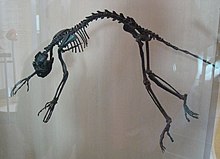This article includes a list of references, related reading, or external links, but its sources remain unclear because it lacks inline citations. (March 2012) |
| Notharctinae Temporal range: Early-Middle Eocene
| |
|---|---|

| |
| Notharctus tenebrosus | |
| Scientific classification | |
| Domain: | Eukaryota |
| Kingdom: | Animalia |
| Phylum: | Chordata |
| Class: | Mammalia |
| Order: | Primates |
| Suborder: | Strepsirrhini |
| Family: | †Notharctidae |
| Subfamily: | †Notharctinae Trouessart, 1879 |
| Genera | |
Notharctinae is an extinct subfamily of primates that were common in North America during the early and middle Eocene (55-34 million years ago). The six genera that make up the group (Cantius, Pelycodus, Copelemur, Hesperolemur, Notharctus, and Smilodectes) contain species that are among the most primitive of the adapiform group, which is one of the most primitive groups of primates. The evolutionary history of this subfamily has been comparatively well documented and has been used to argue for evolutionary gradualism. Though it is generally accepted that adapiforms gave rise to modern day lemurs and lorises, it is not currently known which branch of Adapiformes these living species are most closely related to. Notharctines became extinct in the middle Eocene, most likely because of a combination of factors including climatic change and competition with other North American primates.